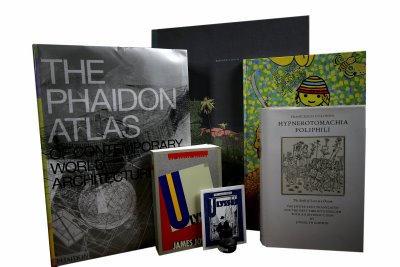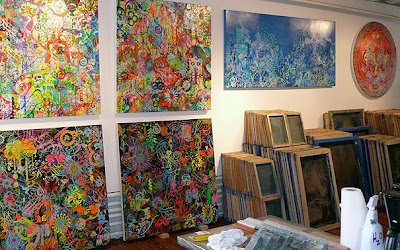Here, with the other largest books I own, is it. Taken with a 16-35mm lens on the wider end of the zoom. KE7 is in the back; it’s bigger than it looks, due to the lens distortion.
For reference, that’s Chippendale’s mammoth Ninja on the right. Contemporary World Architecture on the left comes with a plastic briefcase so you can actually carry the thing. The only book I know bigger than KE7 is GOAT; it weighs 75 pounds, and the copy I saw covered an entire table. So KE7‘s smaller & cheaper; GOAT‘s like 4 grand.
I’ve paged through KE7 twice, but I don’t know how to read it. Maybe on a podium standing up. In the Parthenon. The best comics, I couldn’t get close enough to read at the words.
For the others, several disappoint me– Jaime Hernandez’s, for instance– for failing to address the scale. Others, like the Johnny Ryan page, disappoint for being boring cover versions of himself. (And including them over, say, Vanessa Davis, Renee French, Lauren Weinstein, and Geneviève Castrée’s a shame. And a chance to note that only four women artists are in the book, for whatever reason; I would have liked to see a Lynda Barry collage rather than coprophiliac doodles.) The exception that proves the rule for these is John Hankiewicz’s entry, with the same panel drawn over and over, wonderfully, unrelentingly claustrophobic.
The best works are quite stunning. And a fulfillment of the promise of KE4. They come from cartoonists active as painters and printmakers– like Leif Goldberg, whose comics I dislike but whose prints I collect. And Nilsen, Santoro, Furie, Boyle. Carol Tyler has a beautifully painted page; Kevin H. seems to sum up his career in just a few giant panels. Ben Katchor plays with scale first, then with newspaper format; Tom Gauld shows off why his art’s simplicity is deceptive. CF turns in a double-splash that looks as good as any of his silkscreen prints.
You could buy 50-60 frames, cut the spine, and open a gallery.
The two artists who best exemplify KE7 are Dan Zettwoch and Xavier Robel (half of Elvis Studio). Zettowch turns in an epic from the tailgate to the gridiron; Robel’s got some insane constructivism going on. One’s traditional, one experimental; both brilliantly pitch scale and color against the unique opportunity of these huge, huge pages.









